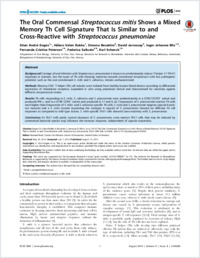The oral commensal Streptococcus mitis shows a mixed memory Th cell signature that is similar to and cross-reactive with Streptococcus pneumoniae
- Engen, Stian André Department of Oral Biology, University of Oslo, Oslo, Norway
- Rukke, Håkon Valen Department of Oral Biology, University of Oslo, Oslo, Norway
- Becattini, Simone Institute for Research in Biomedicine (IRB), Faculty of Biomedical Sciences, Università della Svizzera italiana, Switzerland
- Jarrossay, David Institute for Research in Biomedicine (IRB), Faculty of Biomedical Sciences, Università della Svizzera italiana, Switzerland
- Blix, Inger Johanne Department of Oral Biology, University of Oslo, Oslo, Norway, Department of Periodontology, University of Oslo, Oslo, Norway
- Petersen, Fernanda Cristina Department of Oral Biology, University of Oslo, Oslo, Norway
- Sallusto, Federica Institute for Research in Biomedicine (IRB), Faculty of Biomedical Sciences, Università della Svizzera italiana, Switzerland
- Schenck, Karl Department of Oral Biology, University of Oslo, Oslo, Norway
-
13.08.2014
Published in:
- Plos one. - 2017, vol. 9, no. 8, p. e104306
English
Background: Carriage of and infection with Streptococcus pneumoniae is known to predominantly induce T helper 17 (Th17) responses in humans, but the types of Th cells showing reactivity towards commensal streptococci with low pathogenic potential, such as the oral commensals S. mitis and S. salivarius, remain uncharacterized. Methods: Memory CD4+ T helper (Th) cell subsets were isolated from healthy human blood donors according to differential expression of chemokine receptors, expanded in vitro using polyclonal stimuli and characterized for reactivity against different streptococcal strains. Results: Th cells responding to S. mitis, S. salivarius and S. pneumoniae were predominantly in a CCR6+CXCR3+ subset and produced IFN-γ, and in a CCR6+CCR4+ subset and produced IL-17 and IL-22. Frequencies of S. pneumoniae-reactive Th cells were higher than frequencies of S. mitis- and S. salivarius-specific Th cells. S. mitis and S. pneumoniae isogenic capsule knock-out mutants and a S. mitis mutant expressing the serotype 4 capsule of S. pneumoniae showed no different Th cell responses as compared to wild type strains. S. mitis-specific Th17 cells showed cross-reactivity with S. pneumoniae. Conclusions: As Th17 cells partly control clearance of S. pneumoniae, cross-reactive Th17 cells that may be induced by commensal bacterial species may influence the immune response, independent of capsule expression.
- Language
-
- English
- Classification
- Biology, life sciences
- License
- Open access status
- gold
- Identifiers
-
- RERO DOC 326779
- DOI 10.1371/journal.pone.0104306
- ARK ark:/12658/srd1319025
- Persistent URL
- https://n2t.net/ark:/12658/srd1319025
Statistics
Document views: 191
File downloads:
- Texte intégral: 159
